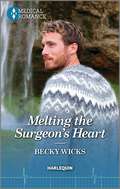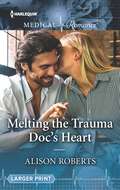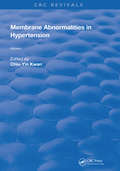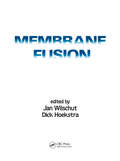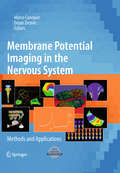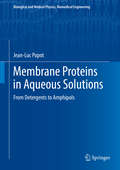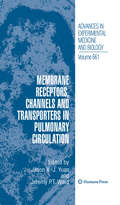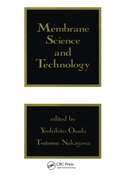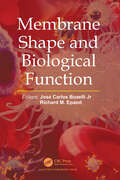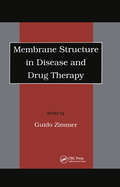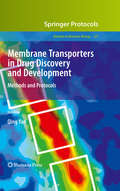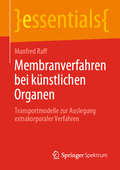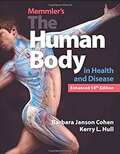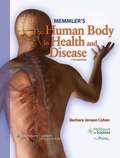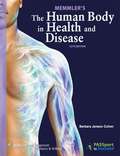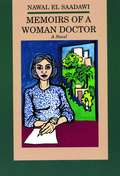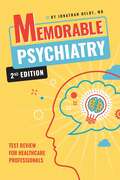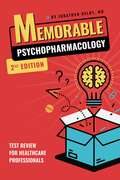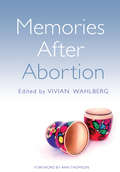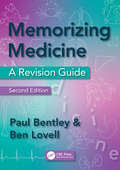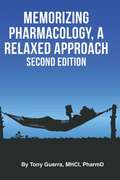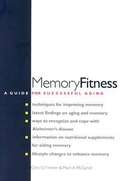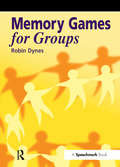- Table View
- List View
Melt Extrusion
by Michael A. Repka Nigel Langley James DinunzioThis volume provides readers with the basic principles and fundamentals of extrusion technology and a detailed description of the practical applications of a variety of extrusion processes, including various pharma grade extruders. In addition, the downstream production of films, pellets and tablets, for example, for oral and other delivery routes, are presented and discussed utilizing melt extrusion. This book is the first of its kind that discusses extensively the well-developed science of extrusion technology as applied to pharmaceutical drug product development and manufacturing. By covering a wide range of relevant topics, the text brings together all technical information necessary to develop and market pharmaceutical dosage forms that meet current quality and regulatory requirements. As extrusion technology continues to be refined further, usage of extruder systems and the array of applications will continue to expand, but the core technologies will remain the same.
Melting the Surgeon's Heart
by Becky WicksCan the new search and rescue paramedic break through the brooding surgeon&’s icy barriers? Escape on an Icelandic adventure with Becky Wicks&’s latest Harlequin Medical Romance to find out! CAN SHE THAW HIS FROZEN HEART? Haunted by his father&’s infamous financial crimes, renal surgeon Gunnar Johansson has sworn off marriage and children. He won&’t subject anyone else to an entire country&’s scorn! Isolating himself, he volunteers for Reykjavik&’s search and rescue. But new paramedic Mahlia is a temptation he never saw coming! Soon her warmth and courage when battling Iceland&’s harshest elements—and her own painful past—threaten to melt his icy resolve…From Harlequin Medical: Life and love in the world of modern medicine.
Melting the Trauma Doc's Heart: From Heartache To Forever (yoxburgh Park Hospital) / Melting The Trauma Doc's Heart (Harlequin Lp Medical Ser.)
by Alison RobertsHe ran away from his past…Is she a reason to stop running?Trauma doctor Zac Cameron escaped the horrors of the battlefield and settled in a small community hospital. He’s just about coping until an unexpected visitor—renowned surgeon Dr. Olivia Donaldson—whirls into town. She might be his boss’s estranged daughter, but their chemistry’s instant—and irresistible! Yet Zac’s emotions are completely off-limits, unless Olivia’s the one who can thaw his frozen heart…?“I read this in one sitting. This was such a heart-felt story. I loved the characters.The author really did a fantastic job…. I highly recommend this story to anyone. It was a real treat to read.”— Goodreads on Pregnant with Her Best Friend’s Baby“This had a little bit of everything, dipping its toes into fairytale waters and bringing a Cinderella-like feel…. And Alison Roberts balances everything pretty-much perfectly bringing an uplifting romance between two endearing characters which simply leaves your heart sighing happily.”—Goodreads on Their Newborn Baby Gift
Membrane Abnormalities In Hypertension (Routledge Revivals #1)
by Chiu-Yin KwanFirst Published in 1989, this two-volume set offers a full insight into membrane abnormalities during a state of hypertension. Carefully compiled and filled with diagrams, references and information this set is recommended for students of medicine and other professionals in their respective fields.
Membrane Fusion
by Jan WilschutThis balanced volume provides a broad and coherent overview of recent progress in membrane fusion research—highlighting an interdisciplinary treatment of the subject from the fields of biophysics, biochemistry, cell biology, virology, and biotechnology—in a single volume., Featuring easy-access sections on the general properties of membranes and applications of membrane fusion techniques, this valuable sourcebook outlines membrane structure, lipid polymorphism, and intermembrane forces ... covers membrane fusion in model systems ... presents the fusogenic properties of enveloped viruses ... discusses the fusion and flow of intracellular membranes and cell-cell fusion occurring during fertilization and myogenesis ... offers applications of membrane fusion techniques in cell-biological research and biotechnology ... and more. Supplying a comprehensive view of this exciting topic, Membrane Fusion is a working resource for molecular, cell, and membrane biologists; biophysicists; biochemists; virologists; biotechnologists; microbiologists; immunologists; physiologists; and graduate and medical school students in biophysics, biochemistry, physiology, virology, cell biology, and biotechnology.
Membrane Potential Imaging in the Nervous System
by Dejan Zecevic Marco CanepariThe book is structured in five sections, each containing several chapters written by experts and major contributors to particular topics. The volume starts with a historical perspective and fundamental principles of membrane potential imaging and continues to cover the measurement of membrane potential signals from dendrites and axons of individual neurons, measurements of the activity of many neurons with single cell resolution, monitoring of population signals from the nervous system, and concludes with the overview of new approaches to voltage-imaging. The book is targeted at all scientists interested in this mature but also rapidly expanding imaging approach.
Membrane Proteins in Aqueous Solutions: From Detergents to Amphipols (Biological and Medical Physics, Biomedical Engineering)
by Jean-Luc PopotThis book is the first to be entirely devoted to the challenging art of handling membrane proteins out of their natural environment, a key process in biological and pharmaceutical research, but one plagued with difficulties and pitfalls. Written by one of the foremost experts in the field, Membrane Proteins in Aqueous Solutions is accessible to any member of a membrane biology laboratory. After presenting the structure, functions, dynamics, synthesis, natural environment and lipid interactions of membrane proteins, the author discusses the principles of extracting them with detergents, the mechanisms of detergent-induced destabilization, countermeasures, and recent progress in developing detergents with weaker denaturing properties. Non-conventional alternatives to detergents, including bicelles, nanodiscs, amphipathic peptides, fluorinated surfactants and amphipols, are described, and their relative advantages and drawbacks are compared. The synthesis and solution properties of the various types of amphipols are presented, as well as the formation and properties of membrane protein/amphipol complexes and the transfer of amphipol-trapped proteins to detergents, nanodiscs, lipidic mesophases, or living cells. The final chapters of the book deal with applications: membrane protein in vitro folding and cell-free expression, solution studies, NMR, crystallography, electron microscopy, mass spectrometry, amphipol-mediated immobilization of membrane proteins, and biomedical applications. Important features of the book include introductory sections describing foundations as well as the state-of-the-art for each of the biophysical techniques discussed, and topical tables which organize a widely dispersed literature. Boxes and annexes throughout the book explain technical aspects, and twelve detailed experimental protocols, ranging from in vitro folding of membrane proteins to single-particle electron cryomicroscopy, have been contributed by and commented on by experienced users. Membrane Proteins in Aqueous Solutions offers a concise, accessible introduction to membrane protein biochemistry and biophysics, as well as comprehensive coverage of the properties and uses of conventional and non-conventional surfactants. It will be useful both in basic and applied research laboratories and as a teaching aid for students, instructors, researchers, and professionals within the field.
Membrane Receptors, Channels and Transporters in Pulmonary Circulation
by Jason X. Yuan Jeremy P. WardMembrane Receptors, Channels and Transporters in Pulmonary Circulation is a proceeding of the 2008 Grover Conference (Lost Valley Ranch and Conference Center, Sedalia, Colorado; September 3-7, 2008), which provided a forum for experts in the fields of those receptors, channels and transporters that have been identified as playing key roles in the physiology and pathophysiology of the pulmonary circulation. The book rigorously addresses: i) recent advances in our knowledge of receptors, channels and transporters and their role in regulation of pulmonary vascular function; ii) how modulation of expression and function of receptors, channels and transporters and their interrelationships contribute to the pathogenesis of pulmonary vascular disease; and iii) the therapeutic opportunities that may be revealed by enhancing our understanding of this area. The overall goal was to explore the mechanisms by which specific receptors, channels and transporters contribute to pulmonary vascular function in both health and disease, and how this knowledge may lead to novel interventions in lung dysplasia, pulmonary edema, lung injury, and pulmonary and systemic hypertension to reduce and prevent death from lung disease. Membrane Receptors, Channels and Transporters in Pulmonary Circulation is divided into six parts. Part 1 (Ion Channels in the Pulmonary Vasculature: Basics and New Findings) is designated for basic knowledge and recent findings in the research field of ion channels in pulmonary circulation. There are five chapters in Part I discussing the function, expression, distribution and regulation of various ion channels present in pulmonary vascular smooth muscle cells and how these channels are integrated to regulate intracellular Ca2+ and cell functions. Part II (TRP Channels in the Pulmonary Vasculature: Basics and New Findings) is composed of five chapters that are exclusively designed to discuss the role of a recently identified family of cation channels, transient receptor potential (TRP) channels, in the regulation of pulmonary vascular tone and arterial structure. Part III (Pathogenic Role of Ion Channels in Pulmonary Vascular Disease) includes four chapters that discuss how abnormal function and expression of various ion channels contribute to changes in cell functions and the development of pulmonary hypertension. Part IV (Receptors and Signaling Cascades in Pulmonary Arterial Hypertension) consists of five chapters devoted to the role of bone morphogenetic protein receptors, Notch receptors, serotonin receptors, Rho kinase and vascular endothelial growth factor receptors in the development of pulmonary arterial hypertension. Part V (Receptors and Transporters: Role in Cell Function and Hypoxic Pulmonary Vasoconstriction) includes four chapters designed to illustrate the potential mechanisms involved in oxygen sensing and hypoxia-induced pulmonary vasoconstriction and hypertension. Part VI (Targeting Ion Channels and Membrane Receptors in Developing Novel Therapeutic Approaches for Pulmonary Vascular Disease) consists five chapters which discuss the translational research involving on membrane receptors, channels and transporters, including their potential as novel drug targets. We hope that Membrane Receptors, Channels and Transporters in Pulmonary Circulation will allow readers to foster new concepts and new collaborations and cooperations among investigators so as to further understand the role of receptors, channels and transporters in lung pathophysiology. The ultimate goal is to identify new mechanisms of disease, as well as new therapeutic targets for pulmonary vascular diseases. An additional outcome should be enhanced understanding of the role of these entities in systemic vascular pathophysiology, since the conference will include researchers and clinicians with interests in both pulmonary and systemic circulations.
Membrane Science and Technology
by Yoshihito Osada Tsutomu NakagawaThis volume covers the theory and applications of transport phenomena in synthetic membranes - describing modern membrane preparation methods, structures, characteristics and properties.;Examining different types of membranes and how they are used, Membrane Science and Technology: presents the physical and chemical fundamentals of membrane science;
Membrane Shape and Biological Function
by Richard M. Epand José Carlos BozelliMembrane Shape and Biological Function is an important guide for anyone interested in the dynamic world of biological membranes. The book explores how membrane shape influences crucial biological processes and highlights its practical applications. It delves into the mechanics of lipid bilayers, their role in cellular processes, and computational methods for understanding membrane remodeling, including real-world applications such as the Golgi apparatus' structure and function, the role of inositol phospholipids in cellular organization, membrane fusion in cell biology, and the potential of lipid bilayers in neuromorphic computing. This comprehensive resource is valuable for students, researchers, and anyone curious about membrane biology.
Membrane Structure in Disease and Drug Therapy
by Svante CornellThis study asserts that cellular and intracellular membranes are active in every aspect of the body's physiology and pathophysiology. It compares secondary through to quaternary structures and protien sequences and guages their influence on health, disease and drug therapy. The book highlights the importance of correlations, homologies and categori
Membrane Transporters in Drug Discovery and Development
by Qing YanStudies of membrane transporters have had a great impact on our understanding of human diseases and the design of effective drugs. In Membrane Transporters in Drug Discovery and Development: Methods and Protocols, expert researchers provide practical methodologies of the ongoing research on membrane transporters, considering applications of transporter technologies in drug discovery and development. Chapters include new and useful fields and methodologies, including pharmacogenomics, nutrigenomics, systems biology, bioinformatics, nuclear magnetic resonance (NMR), imaging, and quantitative real-time-PCR. Transporter studies in drug discovery and development for various diseases are discussed, including neuropsychiatric disorders, cardiovascular diseases, ophthalmic diseases, cancer, and diabetes. Composed in the highly successful Methods in Molecular BiologyTM series format, each chapter contains a brief introduction, step-by-step methods, a list of necessary materials, and a Notes section which shares tips on troubleshooting and avoiding known pitfalls. Wide-ranging and current, Membrane Transporters in Drug Discovery and Development: Methods and Protocols delivers a collection of practical protocols that can be used immediately in the lab, along with critical surveys of key topics by leading researchers in the field.
Membranverfahren bei künstlichen Organen: Transportmodelle zur Auslegung extrakorporaler Verfahren (essentials)
by Manfred RaffKünstliche Organe sind Membranmodule, welche in einem extrakorporalen Kreislauf Blutinhaltsstoffe austauschen bzw. entfernen. Dabei kommen die klassischen Prinzipien der Crossflow- und der Gegenstromverfahren zur Anwendung. Manfred Raff zeigt, wie für die Auslegung derartiger Membranverfahren aus Modellen am differentiellen Membranelement funktionale Zusammenhänge von Zielgrößen und geometrischen, stofflichen und Betriebsparametern für das gesamte Modul abgeleitet werden. Die Ergebnisgleichungen können auch für technische Anwendungen eingesetzt werden. Der Autor:Manfred Raff hat sich in seinem Berufsleben mit dem wissenschaftlichen Schwerpunkt Membrantechnologie beschäftigt. Er war zunächst in der Industrie in der Forschung, Entwicklung und Produktion von Membranen und Modulen tätig. Später hat er als Hochschullehrer an der Hochschule Furtwangen Verfahrenstechnik gelehrt und Membranthemen, wie Messung der Porengrößenverteilung in Membranen, Untersuchung des Stofftransports in der künstlichen Leber, Simulation des Stofftransports bei der Highflux-Dialyse, erforscht. Nach der Pensionierung arbeitet er weiterhin als Lehrbeauftragter an der HFU, Campus Schwenningen.
Memmler's The Human Body In Health And Disease, Enhanced Edition With Navigate 2 Premier Access
by Kerry L. Hull Barbara Jansen CohenMemmler's The Human Body in Health and Disease, Fourteenth Edition is a textbook for introductory-level allied health and nursing students who need a basic understanding of anatomy and physiology, the interrelationships between structure and function, and the effects of disease on body systems. The features and content specifically meet the needs of those who may be starting their health career preparation with little or no science background. The Fourteenth Edition has been revised and updated where needed to improve organization of the material and to reflect current scientific thought.
Memmler's The Human Body in Health and Disease (11th Edition)
by Barbara Janson Cohen Jason James TaylorThis widely read classic is an excellent primer on normal and abnormal anatomy, physiology and pathophysiology, basic microbiology, chemistry, and the human disease process. With a new design and a robust new multimedia electronic ancillary package, this Eleventh Edition will be even more engaging and understandable for students with diverse learning styles. This edition's new artwork includes real dissection photographs from Rohen's Color Atlas of Anatomy, Sixth Edition. New Disease in Context case scenarios integrated throughout each chapter show how content is applied to real-life situations. Icons direct students to relevant electronic materials.
Memmler's The Human Body in Health and Disease (12th Edition)
by Barbara Janson Cohen Kerry L. Hull Jason James TaylorMemmler's The Human Body in Health and Disease is a textbook for introductory-level health professions and nursing students who need a basic understanding of anatomy and physiology, the interrelationships between structure and function, and the effects of disease on body systems.
Memoirs Of A Woman Doctor
by Catherine Cobham Nawal El Saadawi<P>Rebelling against the constraints of family and society, a young Egyptian woman decides to study medicine, becoming the only woman in a class of men. Her encounters with the other students- as well as the male and female corpses in the autopsy room- intensify her dissatisfaction with and search for identity. She realizes men are not gods as her mother had taught her, that science cannot explain everything, and that she cannot be satisfied by living a life purely of the mind. <P>After a brief and unhappy marriage, she throws herself into her work, becoming a successful physician, but at the same time, she becomes aware of injustice and hypocrisy in society. Fulfillment and love come to her at last in a wholly unexpected way.
Memoirs of Childhood and Youth
by Albert SchweitzerAutobiographical reflections on a boyhood that led to an astonishing intellectual career.
Memorable Psychiatry
by Jonathan HeldtThe best and easiest way to learn psychiatry! Clinically oriented for all healthcare providers, including physicians, nurses, psychologists, pharmacists, physician assistants, and social workers Covers all types of psychiatric illness including depression, anxiety, bipolar disorder, schizophrenia, addiction, personality disorders, and more Incorporates recent advances in neuroscience to reflect a modern understanding of these conditions Original mnemonics for all major diagnoses Visual aids on nearly every page Over 150 original practice questions Summary page with all mnemonics for easy reference Second edition featuring dozens of new and improved mnemonics
Memorable Psychopharmacology
by Jonathan HeldtThe best and easiest way to learn psychopharmacology! Clinically oriented for all healthcare providers, including physicians, nurses, pharmacists, psychologists, physician assistants, and social workers Covers all major classes of psychiatric medications, including antidepressants, antipsychotics, mood stabilizers, and more Reviews the most common recreational drugs, from caffeine and alcohol to heroin and cocaine, with a focus on clinically important information. More than 100 original mnemonics Hundreds of high-quality visual aids Over 130 boards-style practice questions Summary page with all mnemonics for easy reference Second edition featuring over a dozen of the newest medications
Memories After Abortion
by Beverley Hancock Vivian WahlbergThis book contains a foreword by Ann Thompson, Professor of Midwifery, University of Manchester. This illuminating book describes young people's thoughts and feelings before and after an abortion, and includes their experiences in the long term. It increases understanding and stimulates discussion of abortion issues without bias, and incorporates political, religious, social, physical and mental considerations in its wide-ranging approach. The personal narratives from both women and men make the issues particularly powerful. "Memories After Abortion" offers thought provoking ideas for all health and social care professionals involved in pregnancy issues. Undergraduate and postgraduate health and social care students, counsellors, therapists, teachers and youth/religious leaders will also find it invaluable. 'Consideration of abortion causes a lot of distress, anxiety and debate within society. This book should be read by women and men so that they can debate and understand each others' views and experiences in their relationships. It should also be read by nurses, midwives, doctors, health-service administrators and those providing social care.' - Ann M Thomson, in the Foreword.
Memorizing Medicine: Second Edition
by Paul Bentley Ben LovellThis book takes a unique approach to 'learning medicine' in a manner that places primary emphasis on recall. Drawing upon well-established psychological principles, it uses a broad range of strategies to maximize the ability of the reader to recollect large swathes of information at a later date. The result is an original and refreshing book in which no two pages are quite alike, and where facts are presented in a hierarchical fashion so that essential features of each condition or symptom can be grasped immediately, while finer points are given in more detailed reading.
Memorizing Pharmacology: A Relaxed Approach
by Tony GuerraCan you learn pharmacology in a day? Yes. Whether you're studying for the PTCB, ExCPT, NCLEX, NAPLEX, USMLE Step-1, PANCE, or just want to pass a pharmacology exam tomorrow, it is a subject you need to, but don't want to deal with. As a working parent of 7-year-old triplet daughters, I understand time management presents one of the greatest barriers to my pharmacology students' success. Many students feel cold overwhelm and information overload. After this book. This easy-to-read guide organizes pharmacology into manageable, logical steps you can fit in short pockets of time. The proven system helps you memorize medications quickly and form immediate connections. With mnemonics from students and instructors, you'll see how both sides approach learning. After you've finished the 300 Top Drugs in this book, reading pharmacology exam questions will seem like reading plain English. You'll have a new understanding of pharmacology to do better in class, clinical and your board exam. You'll feel the confidence you'd hoped for as a future health professional. The secret is that if you learn drugs in a certain order, you can remember them for as long as you like.
Memory Fitness: A Guide for Successful Aging
by Gilles O. Einstein Mark A. McdanielDo all adults experience memory difficulties as they age? What is the difference between normal memory change and the symptoms of Alzheimer's disease? Is it possible to stem--or even reverse--memory decline? This timely book is a comprehensive guide for the growing number of adults who are eager to learn how aging affects memory and what can or cannot be done about it. Gilles Einstein and Mark McDaniel, widely respected for their research and lectures on memory, explain how memory works and how memory processes change with age. Based on up-to-date and rigorous scientific evidence, they also offer *techniques and strategies for improving memory in everyday life *alternatives to hard-to-use mnemonic techniques *physical and mental exercises that can enhance memory *a review of drugs and nutritional supplements touted to enhance memory *a complete discussion of Alzheimer's disease, its symptoms and risk factors, along with guidance for caretakers *and much more. "A clear and scientific evaluation of age-related memory changes and what can be done to minimize them. "--Timothy Salthouse, director, Cognitive Aging Lab, University of Virginia
Memory Games for Groups
by Robin DynesThis wonderfully practical handbook features 80 adaptable and photocopiable games for uses with older people, as well as individuals or groups of all ages. The games can be used as part of a social activities programme, specifically for reminiscence purposes, to help keep people orientated to the world around them, to exercise memory skills or as the prelude to discussion, so that individuals can share difficulties and explore methods of aiding memory.

